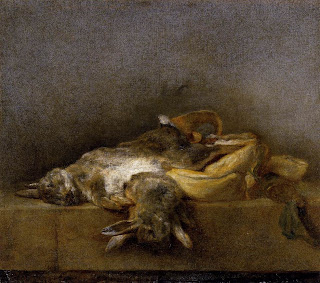Still Life with Rabbits, a Game Bag and a Powder Horn
by Jean-Baptiste-Simeon Chardin, c1755
What is strange is that the French did (and still do) love farmed rabbit and prefer it over wild. Griggers – in all her rabbit recipes – specifies that it must be wild; “[d]omestic rabbit by contrast is as insipid as a battery chicken, even nasty in texture and taste.”
Rabbits were very popular in Northern England as a pie filling in the eighteenth and nineteenth centuries and an alternative meat for a steak and oyster pie – back in the day when oysters were poor people’s food.
If you see a wild rabbit in the butcher’s shop try one – it’s cheaper than a chicken and is truly free-range and organic to boot!
Rabbit – like all game – is very lean so it needs a little helping hand with some additional fat, in this case streaky bacon which also helps the meat go a bit further. Forcemeat balls are often added to dishes like this – something stodgy that again increases bulk. I’m a big fan of forcemeat balls, so I was glad to see them appear in this recipe. Last and by no means least is the herb thyme which is essential in any rabbit dish. Don’t scrimp on it. Because it is used quite liberally, use fresh thyme.
This rabbit pie is the last in a trio of game recipes I cooked whilst I was in England over Christmas. It serves 6 to 8 people.
First of all joint a wild rabbit (or ask your butcher to do it) and soak it in salty cold water for around 1 ½ hours.
I am not quite sure why one needs to do this step. Perhaps it reduces the amount of water in the rabbit by osmosis for some reason? If you know, leave a comment, I’d be most grateful. Drain the rabbit and place it in a saucepan. Pour enough fresh water to cover the beast, bring the water to a boil and let it simmer for 3 or 4 minutes. Drain and dry it.
Roll the rabbit pieces in some seasoned flour and brown it in butter, lard, bacon fat or dripping in a large, deep sauté pan then fry a large chopped onion and 5 or 6 ounces of streaky bacon or salt pork. When lightly browned, add the grated rind of a lemon, a heaped tablespoon of parsley and four good sprigs of thyme.
Add enough light beef or veal stock to just cover. Cover and simmer until the rabbit is cooked. Jane doesn’t give a time here, but it will depend upon the age of the rabbit. Mine took about 1 ½ hours. To test it, I just sampled a bit of leg meat. Let the mixture cool and bone the rabbit if you want; I did because little ones were eating it.
Now the pie needs to be made. Place the mixture in a pie dish, piling it in the middle and scatter forcemeat balls around it (look here for the recipe). If you have a rather broad or long pie dish, it may be worth placing a pie funnel in the centre – I didn’t have one and the pie sank a little.
To cover the pie, roll out some shortcrust or puff pastry. Cut strips from the pastry and use it to line the rim of the dish, gluing it in place with some beaten egg. Next, cover the pie and trim any excess pastry and use it to decorate the top. Glaze with beaten egg.
My niece and nephew, Emma and Harry, expertly decorate the pie
Bake at 220⁰C (425⁰F) for 20-30 minutes and then turn the heat down to 160⁰C (325⁰F) for another 30 minutes. As usual, protect the pastry with some brown paper should it colour too much.
The best picture of the pie I could get -
it got gobbled up pretty fast!
#325 Rabbit Pie. I am on a roll with the pies at the moment because this was another excellent one. The rabbit was very tender and not too rank tasting as the previous rabbit had been. I suppose it is the risk one takes with game. The very lean rabbit was ‘fattened’ up excellently with all the streaky bacon it was fried with. Plus it was complemented perfectly by the fresh thyme and the lemon zest. Really good – now that wild rabbit is getting more common meat in Britain’s butcher shops, there’s no excuse in giving it a try. 8/10











4 comments:
The salt water bath works as a brine to actually create more moisture in a relatively lean protein such as rabbit. Up to 30% of moisture can be lost during cooking so pump more moisture in notice less loss. The science of it actually happens as salt denatures the proteins and then rebinds with the water during the addition of heat. But long (boring) explanation short is the salt makes the rabbit jucier.
You've become an amazing pie maker! That rabbit pie looks fantastic. I'm about to cook a rabbit in a couple of hours - will braise it with bacon, wine & dried plums, & serve with green lentils.
I used to have a lurcher & she got a few rabbits for me, but only buy them these days.
That sounds good! Is it a recipe of your own? I should definitely like to try it...
I think I might get a Jack Russel to train as a rabbiter. Or maybe a couple of polecats...
Thanks A. SK you are a star player. I thought the salt water would have caused it to have less water, but I didn't consider denaturation. And me a biologist as well. Everyday's a school day!
Post a Comment